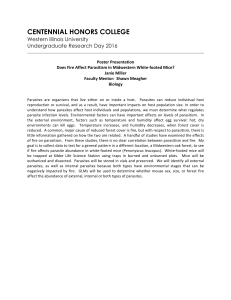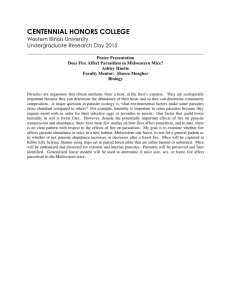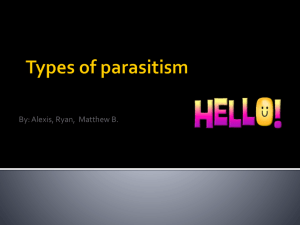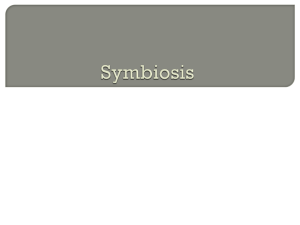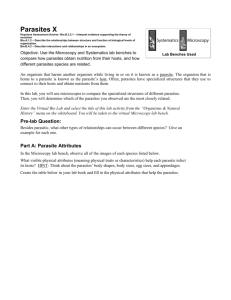Symbiosis Learning outcomes To know the following interspecies relationships and examples of each:
advertisement
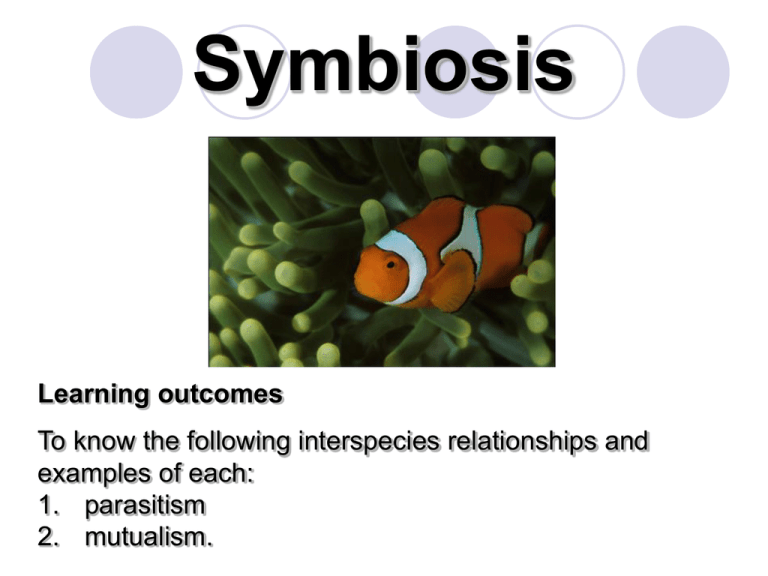
Symbiosis Learning outcomes To know the following interspecies relationships and examples of each: 1. parasitism 2. mutualism. Detailed learning outcomes Symbiotic relationships are co-evolved and specific intimate relationships between members of two different species. 1. Parasitism A parasite benefits in terms of energy or nutrients, whereas a host is harmed by their loss. Parasites often have a limited metabolism so cannot survive out of contact with a host. 2. Mutualism Both mutualistic partner species benefit from the relationship. One example is that of cellulose-digesting protozoa/bacteria living in the guts of many herbivores. Symbiotic relationships Symbiosis Parasitism Mutualism Symbiosis Symbiosis is the close relationship between two different species, eg the relationship between nitrogen-fixing soil bacteria (Rhizobia) and leguminous plant roots (peas, beans and clover). There are two types of symbiosis: • parasitism • mutualism. Parasitism A parasite lives on another organism A B (the host) from which it obtains food. This: Harmed Benefits • benefits the parasite • harms (or kills) the host. Some parasites (ectoparasites) live on the outer skin of the host: ticks leech fleas Parasitism Some parasites (endoparasites) live inside the host (usually in vertebrates): tapeworm Living with parasites Only poor parasites kill their host as this is not to their advantage, especially for obligate parasites. There is a balance between parasitic damage and host defence, so the relationship is relatively stable. Diseases often occur in cycles as parasite and host co-evolve. Secondary host species or vectors Vectors are organisms that transmit parasites, usually insects and ticks. These vectors are essential for the development of the infectious stage of the lifecycle of some parasites before they are transmitted to the next host (eg mosquitoes transmit the malarial parasite). Some of these vectors therefore have a double aspect of parasitism. Host–parasite co-evolution As a host evolves defence mechanisms against the parasite, so the parasite evolves mechanisms to overcome the defence. This has led to many host–parasite interactions being species specific, in other words most parasites only infect a particular host. Types of parasite Parasites may be animals or plants. Viruses are parasites. Unicellular organisms, such as some bacteria, are parasites. Multicellular organisms, such as worms and insects, may be parasites. Mutualism Mutualism is a specialist A relationship between two organisms that is beneficial to both. Benefits Lichens are composed of fungus and algae in a beneficial relationship. http://www.snh.org.uk/images/publications /lichens03.jpg B Benefits Herbivores have special cellulose-digesting microorganisms in their stomachs. www.co2calculator.wordpress.com Leguminous plants and Rhizobium bacteria These bacteria live freely in soil. They are able to infect the roots of leguminous plants and form nodules. Inside the nodules bacteria obtain energy from their host and supply nitrogen compounds in return. Picture: www.apsnet.org Fungi and algae (lichens) Lichens are able to colonise areas where other plants are unable to grow. The fungal part of the lichen produces tough cellulose walls and secretes mineral-digesting chemicals while receiving carbohydrate. The algal part of the lichen photosynthesises and receives protection and essential minerals. Herbivores and gut bacteria Herbivores cannot produce cellulosedigesting enzymes. Bacteria which can do this are found in the alimentary tract of herbivores. These bacteria receive food and shelter, and aid plant digestion. Ants and aphids Some species of ants ‘farm’ aphids. They move them from plant to plant and protect them from predators. In return the aphids secrete a sugary liquid that the ants drink. Terrestrial plants and pollinating animals Many plants have evolved special flower shapes which allow only one kind of animal near them. The animal depends on the nectar it receives as a reward for its visit. The plant depends on the animal to transport its pollen between flowers. Summary Species A Species B Parasitism Mutualism + + + - Acknowledgments Many thanks to R. Purdie from Sanquhar Academy for the use of some materials.

